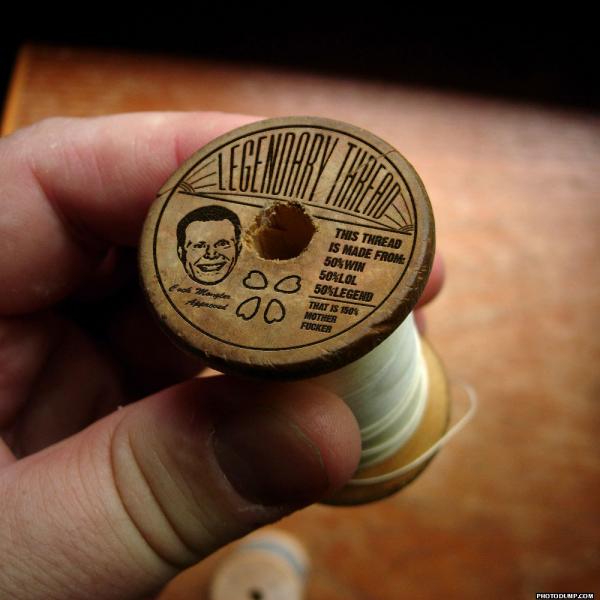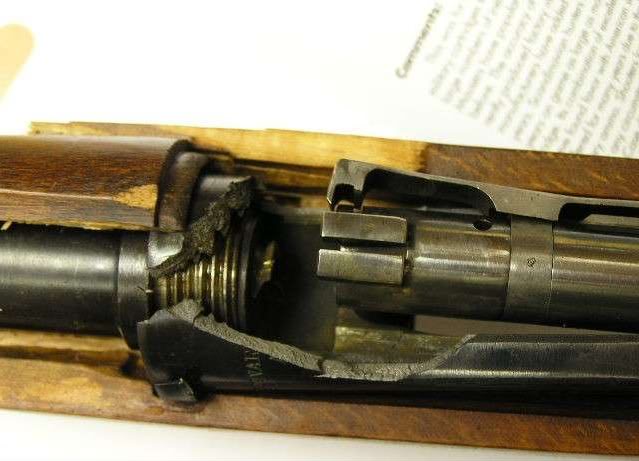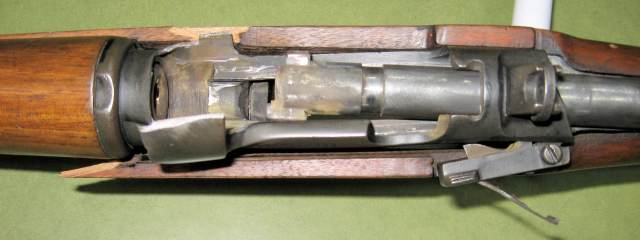-
Moderator
(Book & Video Review Corner)


[QUOTE=louthepou;60169]I found a somewhat humorous "Legendary Thread" picture, I think this thread qualifies as such by now!
 /QUOTE]
/QUOTE]
fixed it!
So I can't spell, so what!!!
Those who fail to learn from history are doomed to repeat it.
Those who beat their swords into ploughshares, will plough for those who don't!
Be polite. Be professional. But, have a plan to kill everyone you meet.
-
Thank You to Gibbs505 For This Useful Post:
-
06-23-2009 09:43 AM
# ADS
Friends and Sponsors

-
Banned


Originally Posted by
Dimitri

I do know that, but at the same time Norma produces full power ammunition for the 8mm Mauser, so that is what I use.
American worries about problems and accidents is a pain, if the end user cant use his or her head then they should not use firearms.
Good thing you aren't a lawyer.
I've used Norma in both an 8mm Persian Carbine and in a couple of .303 Enfields, both showed flattened primers and the casings were rough as a cob on the outside. The rifles were in nearly new condition, so signs of excessive pressure had to be due to the ammunition. The same 8mm loads if used in a 1888 Commision Rifle would have been very unsafe.
Rifles and ammunition are designed within prescribed safety safety limits with margins.
British
Small Arms designers would have not approved the conversion of No4 Enfields to 7.62mm NATO if it was not safe for the lifetime of the rifle as if it was continued to be chambered in 303 British. Perhaps its not as generous of a safety margin as one would like or as there was with the 303 British but it is safe enough to work in battle field and non-war fighting conditions.
Aside from the L42 sniper rifles those 7.62 conversions weren't likely to have seen combat. Non war fighting conditions seem to have been all the L8 was good for
What you are doing now is comparing a British conversion, with properly made British ammunition to **** poor manufacturing in Vietnam and other countries who can't keep QC on their products as somehow a reason to dismiss the standard No.4 action as a battle rifle.
I never "dismiss the standard No.4 as a Battle Rifle", the standard No.4 worked quite well when chambered in .303, that is unless unsuitable ammunition was used for any reason, or ammunition that had degraded from long term exposure to temperatures above 125 degrees. RAF testing of ammunition storage methods found that ammunition cases exposed to direct sunlight on the Indian Northwestern Frontier reached temperatures of 160 degrees for hours at a time. Cordite begins sweating liquid Nitroglycerin at 125 degrees. According to reports on this I've read, including input by Hiram Maxim, the liquid nitroglycerin isn't reabsorbed and collects in the bottom of the case posing a detonation hazard. Dud POF ammo I've broken down had strands that looked melted at the end nearest the primer, and a brown/black substance I'd taken for sealant collected at the edges of the card wad.
ammo I've broken down had strands that looked melted at the end nearest the primer, and a brown/black substance I'd taken for sealant collected at the edges of the card wad.
British surplus 7.62mm NATO is considered some of the best surplus available,
I don't doubt that one bit, they used single base propellants for their 7.62 NATO ammunition so sweating of Nitro was no longer a problem.
But the whole point of NATO's ammunition interchangability program is that every nation's rifles should be able to digest the ammunition of any other NATO member state. As I said tests of the L42 showed that it worked fine with British milspec 144 gr bullet loadings.
Germany
's **** poor manufacture of ammunition is well known from bad jackets on their bullets to bad powders unsuitable for what they are loaded in. Blaming QC of others to find a "weakness" is pretty low ball in my opinion.
The reason you need a designed in safety margin is so Kabooms are unlikely to happen, and if they do that chances of injury or death are minimal.
A rifle that cracks its receiver simply because a cartridge case got wet can't have much of a safety margin.. If that rifle survived the first shot without the shooter realising that his receiver had cracked the next attempt to fire might well be the end of him.
I remember someone saying a few weeks back that the LE receiver was stronger than the SMLE receiver because the LE did not have the cut outs for attachment of the charger bridge or the thumb cut in the left receiver wall. I didn't give that much thought at the time, but that does fit with what Ed posted about the left receiver wall cracking, and the cracking of Lithgow receivers under proof loads at the holes for the Charger Bridge Rivets.
receivers under proof loads at the holes for the Charger Bridge Rivets.
It would also explain why they chose to beef up the No.4 receiver design so much more on the left side than on the right.
So far I think we've established that the British military recognized a number of "inherent weaknesses" of the Enfield SMLE rifle and at different points in time they first attempted to replace it with the No.3, then the P14, and later the No.4. The No.4 was at best marginally stronger than the No.1 but its massive receiver wall eliminated part of the problem introduced by the modifications necessary to update the LE receiver for charger loading.
The previously posted article which revealed spreading of the rear receiver walls of No.5 action bodies, and the similar spreading I recognized with my No.4 which has only used milsurp or medium pressure handloads, suggest that the pressures at which the action body can recover from deformation can easily be exceeded by milsurp ammunition that has degraded over the years.
Something as simple as laquer water proofing or neck sealants hardening with time has been known to greatly increase pull strength of the bullet, and corrosion inside the neck can increase grip of the bullets as well resulting in high pressures from ammunition that looks fine on the surface.
I've recommended babying these old rifles by using only fresh ammunition known to meet SAAMI specs or taylored handloads that get the job done at the lowest pressure modern propellants allow.
Using old milsurp ammo in a valued antique rifle is a false economy, and potentially dangerous.
Ignoring criticisms of the Enfield actions strength when those criticisms were made by men noted as authorities on both the rifle and its ammunition in favor of anecdotes and emotional outbursts of a few collectors isn't very wise.
If you collect any sort of antique then you'd be wise to pay heed to its historical background , the bad along with the good.
I like the Enfield because of its ergonomics, and learned to work around its known lack of strength.
As for the cartridge cases, I never suggested greasing a cartridge. I have pointed out that head gap clearances of from .004 to .006 were found best for the rimmed bottle necked cartridges of this class, and that zero headspace leads to sticky extraction. Head gap clearances of .002 or less were also known to increase group size of Krag rifles.
rifles.
The spring in the action body and bolt body of the Enfields appears to contribute to easy extraction, so thats a plus. Its a hold over from its BP era roots. Its not a plus when higher intensity chamberings like the 7.62 NATO are used.
I figure its knd of sad that some can't accept that the rifle they collect has some known issues. Especially since they then must ignore some features that can be used to their benefit.
Last edited by Alfred; 06-23-2009 at 11:56 AM.
-
Banned

-
Legacy Member


Originally Posted by
Edward Horton

Vas ist los Bubba

Inherent weakness or oiled cartridges and bolt thrust.
(Or did he shoot his Mauser in the rain?)


Your photo is a Swedish Mauser that I believe that was blown up with defective PMC factory ammo. There were a series of photos in a magazine about this one.
Mauser that I believe that was blown up with defective PMC factory ammo. There were a series of photos in a magazine about this one.
This a Spanish FR8. A former M93 Mauser Converted to a Cetme look alike.
less a few oz of shrapnel. 
Last edited by ireload2; 06-23-2009 at 02:33 PM.
-
-
Legacy Member

Protection of the SMLE against the elements

-
-
Legacy Member

>>>Even if the No.4 could be relied upon to hold up to extended firing of 50,000 PSI loads, and I see no reason to believe that it would, the obvious variables in accuracy under the least of adverse weather conditions would greatly limit a 7.62 conversion as a battlerifle.<<<
I could see a properly converted #4 working ok for a while but I would be curious about redloading the fired cases.
The main problems with the #4 chambered to shoot 7.62 Nato is the rather high proof requirement for the 7.62mm round. I can just see the little old man at the proof house oiling up a 7.62mm proof round for a #4.
-
-
Advisory Panel



Originally Posted by
ireload2

Protection of the SMLE against the elements

Yeah - better warn him not to oil his ammo or shoot in the wet. Better also tell him he has a substandard rifle with enlarged bore, a spreading receiver, and dangerous unstable & erosive ammo. ......... 
-
-
Legacy Member


Originally Posted by
Thunderbox

Yeah - better warn him not to oil his ammo or shoot in the wet. Better also tell him he has a substandard rifle with enlarged bore, a spreading receiver, and dangerous unstable & erosive ammo. .........

Looks like he is attempting to keep it dry.
-
-
FREE MEMBER
NO Posting or PM's Allowed


Originally Posted by
Alfred

The rifles were in nearly new condition, so signs of excessive pressure had to be due to the ammunition. The same 8mm loads if used in a 1888 Commision Rifle would have been very unsafe.
Excessive pressures or bad headspace/chambers. Norma 8mm Mauser ammunition is loaded to roughly match (relatively speaking ballistics wise) WW2 and post-war 8mm Loadings. Or atleast the specific loading that I buy that Norma makes seems to match quite well. I couldnt tell you right now I'm a few thousands of miles away from the ammunition boxes.
Either way downloading ammunition is not a substitute for using the wrong ammunition. There is a reason why there is "8mm Mauser I" (.318 diameter) and "8mm Mauser IS" (.323 diameter) plus the "8mm Mauser IRS" which is a rimmed .323 caliber round for break actions.

Originally Posted by
Alfred

Aside from the L42 sniper rifles those 7.62 conversions weren't likely to have seen combat. Non war fighting conditions seem to have been all the L8 was good for
The L8 was a stop gap measure, the British knew they wanted a semi-automatic battle rifle if they were to adopt a new firearm and ammunition, they had trialed the precursor to the FN FAL the FN SAFN49 in 8mm Mauser while Saive was in Britain after the occupation of Belgium
knew they wanted a semi-automatic battle rifle if they were to adopt a new firearm and ammunition, they had trialed the precursor to the FN FAL the FN SAFN49 in 8mm Mauser while Saive was in Britain after the occupation of Belgium . Why the SAFN49 and the 8mm Mauser? Because the arms designer was in the country able to work on his rifle he was developing pre-war, and because the British were already manufacturing 8mm Mauser for use in machine guns that did not feed the 303 British well.
. Why the SAFN49 and the 8mm Mauser? Because the arms designer was in the country able to work on his rifle he was developing pre-war, and because the British were already manufacturing 8mm Mauser for use in machine guns that did not feed the 303 British well.
They were not going to spend alot of time on the L8, when they had other firearms in the horizon.

Originally Posted by
Alfred

unless unsuitable ammunition was used for any reason, or ammunition that had degraded from long term exposure to temperatures above 125 degrees.
And most ammunition degrades with temperature exposure. It is a standard warning on any ammunition, and its in most if not all firearm field manuals from every country, that over heated ammunition is something to be avoided.

Originally Posted by
Alfred

But the whole point of NATO's ammunition interchangability program is that every nation's rifles should be able to digest the ammunition of any other NATO member state.
Yes and no, standard ammunition that can be fired is great. However interchangeability is confused right now with being the same. As long as it can be fired in everyone elses firearms it was good enough performance was another issue. You can see this with the wide variety of manufacturing differences in NATO countries of 7.62x51mm NATO ammunition, as well as the changes many countries did to their ammunition to suit them, even if it means their ammunition is not identical to everyone elses. The closest thing to a standard for performance and function in ammunition is the SS109 ammunition in 5.56x45mm NATO loaded by various countries.

Originally Posted by
Alfred

Ignoring criticisms of the Enfield actions strength when those criticisms were made by men noted as authorities on both the rifle and its ammunition in favor of anecdotes and emotional outbursts of a few collectors isn't very wise.
Both Enfield factory conversions like the ones I listed, and the 303 Epps improved rounds used for decades used charges as high as standard 7.62x51mm NATO (or 308Win) and I have yet to hear of one verifiable accident from any of the people I know who own either "conversions".
So I dont honestly see the issue of this "weakness" that is being claimed.
Dimitri
-
Legacy Member

>>>Both Enfield factory conversions like the ones I listed, and the 303 Epps improved rounds used for decades used charges as high as standard 7.62x51mm NATO (or 308Win) and I have yet to hear of one verifiable accident from any of the people I know who own either "conversions".<<<
So how many people do you really know that really shoot a .303 Epps in a #4.
I am sure you could do it in a P-14. Perhaps all these conversion owners are non-shooting collectors.
The calculations and even visual examination show where the weakest part of the Lee-Enfield design is.
-
/QUOTE]















 PM
PM















